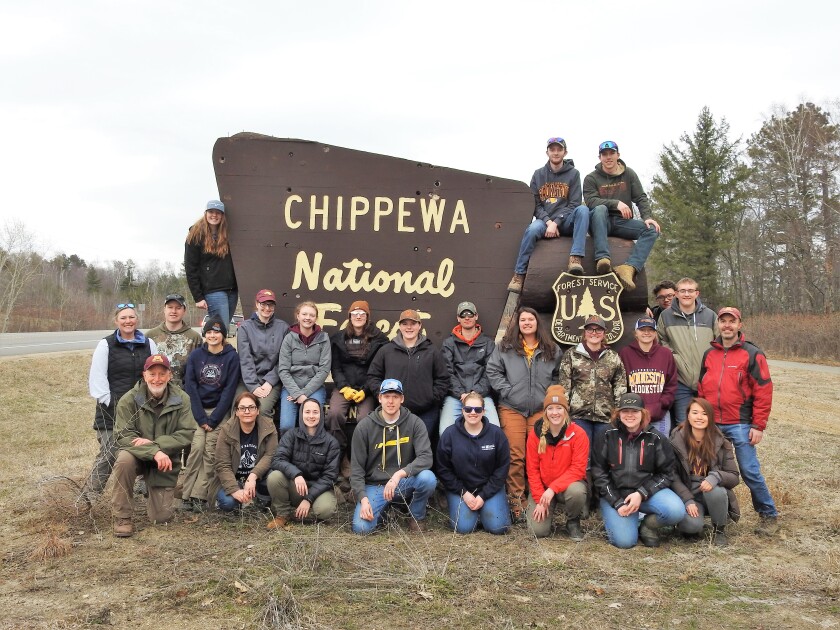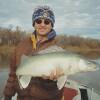CROOKSTON – On a dreary Arbor Day with the threat of yet more rain in the forecast, a group of students and faculty from the University of Minnesota Crookston spent part of the day in Chippewa National Forest continuing a 40-year tradition.
Since 1983, students from UMC have planted more than 206,000 trees in the northern Minnesota national forest under a partnership with the U.S. Forest Service that today is as strong as ever.
ADVERTISEMENT
Marking this year’s 40th tree-planting effort were 24 students and friends from UMC’s Natural Resources Club and three alumni, according to Phil Baird, an associate professor of Natural Resources. Baird, along with Lab Services coordinator Laura Bell and associate professor Matt Simmons, rounded out the planting crew.

They planted 2,100 white pine seedlings in about 3½ hours at a site in the forest east of Cass Lake, Minnesota. Using a tool called a “dibble bar,” which creates a V-shaped trough when pushed into the ground, the crew was able to make quick work of the seedlings, which the Forest Service purchased from a nursery in Cohasset, Minnesota, Baird said.
“It goes pretty fast,” he said. “There’s not a lot of love and attention given to each one. It’s not like you would see (a garden center) installing a $500 landscape tree.”

The UMC crew also removed 3,000 “bud caps” from a stand of trees the Natural Resources Club had previously planted. A bud cap is a piece of paper wrapped and stapled around the terminal bud of a tree to protect it through the next growing season. Besides planting trees in the spring, UMC students make a bud-capping trip to Chippewa National Forest every fall.
After wrapping up their planting work on Arbor Day, many students spent the rest of the weekend at the University of Minnesota’s Itasca Biological Station to enjoy the outdoors before the start of final exams week.
“It’s just a good time for the students to get to know each other and have fun” before finals week, Bell said. “It was raining pretty much the whole time, but they went on hikes, and they had a great time.”
ADVERTISEMENT
Taking root
According to Baird, UMC’s partnership with the U.S. Forest Service took root when he attended a state conference of the Society of American Foresters and met Marty Christensen, who was a timber management assistant ranger for Chippewa National Forest based in Deer River, Minnesota.
“We were talking about ways that we could get students over to the forest and maybe do some volunteer work – get some experience for the resumes,” Baird said.
Christensen came up with a list of forest stands where the students could work, and the rest – as they say – is history.
“I don’t think either of us had the intention that it was going to be an ‘every year forever and ever’ type of thing, but fortunately, it’s turned into that,” Baird said. “It really has become kind of a tradition. When former students come back 10 or 15 years later, it’s one of the first things they’ll immediately talk about rather than that great chemistry lab they had years ago.”
Alumni returning for this year’s tree planting effort were McKena Wilmer and Alec Burklund, who now work for the USFS in the Chippewa National Forest’s Blackduck, Minnesota, district, and Kimie Shiozawa, a Tokyo native who is an interpreter at Deep Portage Learning Center near Hackensack, Minnesota.

In addition, Tom Feiro, a retired Lab Services coordinator at UMC who now lives in Montana, planted a limber pine tree on the Custer-Gallatin National Forest on Arbor Day while the UMC crew was planting in Chippewa National Forest, Bell said.
“Tom played a huge role in establishing and continuing the club’s tree planting tradition with Phil back in the ’80s,” Bell said.
ADVERTISEMENT
Among the students planting trees was Michelle Swyter, a junior from Perham, Minnesota, who gained real world experience last summer as a forestry technician in Chippewa National Forest. Swyter also was among the UMC students planting trees in 2021.
“It’s really nice to be part of a team,” she said. “There’s a lot of collaboration just to get all of the trees in the ground and I think it’s a good experience, especially for the younger students, to realize what it’s like to actually be out in the woods and walking through the brush with the ticks and the bugs.”

Ellie Hintze, a senior from Coon Rapids, Minnesota, and president of the UMC Student Chapter of The Wildlife Society, says working with Forest Service personnel presents networking opportunities that can be crucial to finding jobs, even summer positions such as Swyter’s job last summer as a forestry technician.
“A lot of the students that went on this trip were freshmen this year, so I think it’s giving them a good opportunity to get out and do more hands-on work,” Hintze said. “They’re learning in the classroom, too, but it’s definitely a lot different learning in the classroom vs. going out and doing it – and I think that’s a huge benefit.”
Forest Service perspective
The benefits work both ways, said Audrey Gustafson, silviculturist for the Chippewa National Forest’s Blackduck and Walker, Minnesota, Ranger District.
Silviculture is the practice of managing forests for wildlife, water, recreation, aesthetics and any other combination of forest uses.
“There are so many positive things that come from this,” Gustafson said. “One is, they’re helping us achieve our mission of reforesting the land – right from planting, reforesting and restoring white pine to the landscape. And then, in addition to the planting part of it, it’s just a great partnership, a great collaboration and friendship for all these years.”
ADVERTISEMENT
As a testament to that collaboration, the Forest Service presented the UMC Natural Resources Club with its 2018 Volunteers and Service Award for their years of restoration work in Chippewa National Forest. The award was presented in April 2019 during a virtual presentation by the chief and deputy chief of the Forest Service.

“There are school forests around, but there’s nothing longstanding like this long-term commitment by Phil and Tom and Laura,” Gustafson said. “Nothing else that I’m aware of.”
Even in 2020, when the early months of the COVID-19 pandemic brought all semblance of normal life to a screeching halt, the planting tradition went on as scheduled, though not quite as planned, Gustafson recalls.
That year, Bell came alone, and the two of them planted trees at separate sites, Gustafson said. Between their efforts and additional plantings by multiple Forest Service employees, 3,000 seedlings were planted in 2020, she said.
“We had an interpretation of our rules that said only one of them could come so Laura came,” Gustafson said. “They did not miss 2020 – we made it happen.”

Continuing legacy
With a 40-year tradition of planting trees in Chippewa National Forest to his credit, Baird says he’ll be retired by the time the partnership marks 50 years, joking that Bell “has promised to push me out for the 50th in a wheelchair.”
ADVERTISEMENT
“It’s not a problem – Phil will be there,” Bell said. “We have every intention to continue working with the Forest Service and continuing our legacy. Over 206,000 trees have been planted by our Natural Resources program and clubs. … It’s pretty incredible.”
The Forest Service – especially Christensen and, more recently, Gustafson – deserves a lot of credit for fostering the partnership and providing UMC students with the opportunity to get real world natural resources experience, Baird said.
“Right now, the number of young people that are looking at going into different natural resource careers is on a steady decline, and agencies are seriously concerned about who’s going to step in and fill the shoes for the future,” Baird said. “I think activities like this, and providing opportunities for students to really make a difference, get the students to confirm for themselves that this is what they want to spend the rest of their life doing.”













